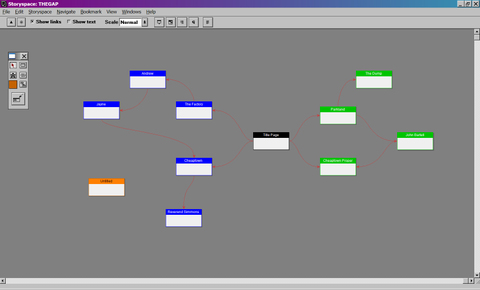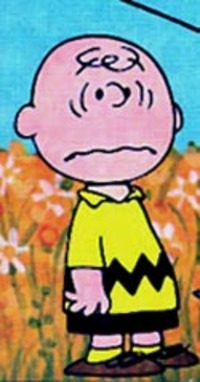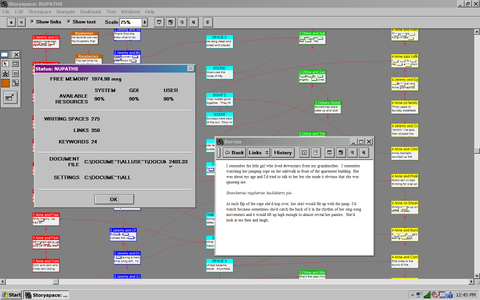STORYSPACE & PROJECTS: Gap – I-Beams
It’s so strange for me to be actually planning out the structure of a story beyond the opening line. Though in some ways, the map as I have it here may be considered dual directional and expanding into whatever areas it claims in its flow. But it’s pretty obvious from just this rudimentary Map View that it’s a narrative that involves man against man, or us versus them.
I just know that it is not within my nature to keep this freeflow going on beyond too many more spaces. I will just have to have them lined up somehow in neat rows that I’ll mess and move around a bit just when someone’s looking or when I post an updated view here to make it appear that I’m not quite as regimented as I tend to be.
What the above really represents is more a placeholder for each of the ideas as they come to me–mostly in story form, meaning written as prose–but there are obvious character and setting spaces that will become prime threads or paths.
One thing I’d noticed while doing some final reading and editing in Paths is that there were several ideas or phrases or images that reappeared, i.e., lion, wind, etc., that without conscious planning flowed right into another space that reinforced the theme. What this tells me is that when you get this entrenched in your story, the clock on the wall is bound to show up in several scenes because you see it in the corner of your mind. With the Storyspace Writing Spaces, these just happen to come up and tie the idea together whereas in straight text, you’ll find sometimes that you wish the author could come up with a different word because it seems repetitive. I’m not sure what I’m saying here, but I think it’s a case of hypertext = reinforcement versus traditional linear = repetition. The reaction, at least as writer, is not “oh shit, I said that already a few pages back,” but rather, “wow, that must be symbolic because I’ve mentioned it twice already.” Maybe just one more of the side benefits of the hypertext environment.


 Editing.
Editing.

 The Lost Children: A Charity Anthology
The Lost Children: A Charity Anthology